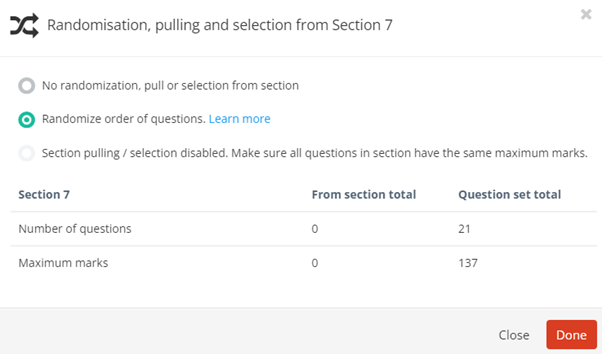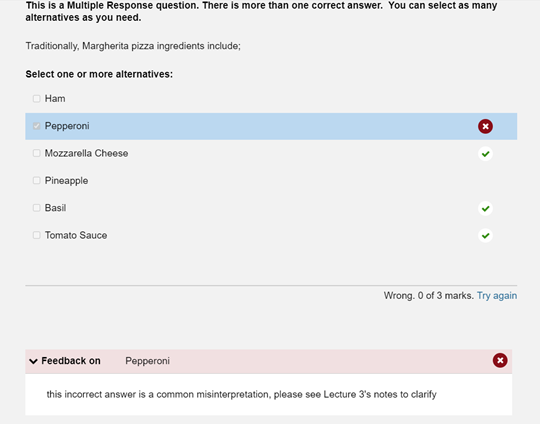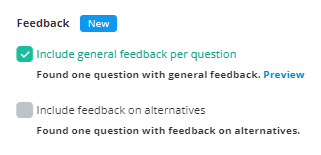Content Creation Features in Inspera
NEW: A vision for education and skills at Newcastle University: Education for Life 2030+
Sections
By default, all the questions you create in a question set are in one section. If you wish to use one section only you do not need to make any adjustments. However, you can choose to split a question set into separate sections. This could be used for grouping purposes if there are separate parts to the exam, or sections can allow the use of additional functionality when creating your exam content.
General options for sections
To add a new section, scroll to the bottom of your question set and select ‘new section’.
Different options will appear under each section you have.

These options include:
- Pencil icon - Edit the name of the section
- Bin icon - Delete the section
- Crossed arrow icon - Drag and drop to move the section within the question set
- Arrows overlap icon - Enable randomisation of the question order
- Columns icon - Alter the layout of the section
Section Layout
Section Layout can be used to alter how the question set is displayed to students. The default layout is one question per page. Section stimulus can be added, this is a one-page/text area that will appear to the left hand of each question within the section.
To enable Section Layout, click on the column icon.
The Section Layout options include:
- Basic layout: One page per question (the default)
- Basic layout: With left stimulus
- Vertical layout: All questions on one page*
- Vertical layout: With left stimulus
- Vertical layout: With top stimulus*
As standard, it’s strongly advised to leave the resize stimulus option ticked ‘on’, as this will assist students with viewing the stimulus:

*It is recommended to use this format if all questions are short in length, long questions (text exceeding 3-5 lines) with such a layout use could interfere with the question view.
Randomisation
The questions within the question set can be presented all to students in a random order. This feature is turned on per section. To access randomisation options, click the randomisation option under your section header.
To randomise the order of the questions select this option using the left hand radio button then click Done.

Once applied, the section will have a banner showing the feature has been applied:

Important note: if you have an instructional document within your section, this will also be part of the random order, it’s recommended that a separate section is created for any instruction which you have before the section with randomisation applied.
Random Pulling
The questions within the question set can be randomly pulled, meaning students will answer a given number of randomly selected questions from within a section. This feature is turned on per each section. To access random pulling options click the random pulling icon under your section header. Select the ‘pull’ option and edit the number of questions you wish to be presented to your students. Click Done to apply.

Once applied the section will have a banner showing the feature has been applied:

Important note: This option is only available if the marks for each question in the section have the same maximum marks. If questions within the section have differing total marks, the feature cannot be enabled.
Implications of using random pulling
The Digital Exams Team recommend ensuring that any random pulling questions are housed within their own section and this feature is used with MCQs only. This is due to restrictions when editing questions after an Inspera exam has taken place. If a question has been used and includes ambiguity and you wish to remove the question’s weighting from the exam, random pulling could impact the final score for students. Please see the scenario below for a further explanation.
Scenario
In this example, the Question Set has x10 questions which are multiple response. I have opted to use random pulling so students answer x8 questions. When marking, I discover a question is ambiguous and I need to remove this from the exam. If I remove the question from the exam and I have used random pulling, I cannot guarantee that every student answered that question. Which could mean my cohort have differing totals. Student X who answered questions 1-8 as per random assignment will have 8 questions making up their total. Student Y who answered questions 2-10 as per random assignment will have 7 questions making up their total (as question 10 has had to be ‘removed’).
MCQs can still be edited when using the Random Pulling feature. MCQs have an option for an answer key edit, which allows a new answer to be inputted after the exam and then marked as correct. This is the only question type with this functionality available.
To see the different edits which can be made after an exam has ran please see our marking video covering this. Please be aware random pulling is not depicted in this video.
Candidate Selected Questions (CSQs)
The questions within the question set can be selected by the student, meaning students get a choice of which question(s) to answer. This feature is turned on per each section. To access candidate selected questions click the randomisation icon under your section header. Select the ‘allow candidates to select’ option and edit the number of questions you wish to be answered by your students. Click Done to apply. Note: Students will see all question options.

Once applied the section will have a banner showing the feature has been applied:

Important note: This option is only available if the marks per each question in the section have the same maximum marks. If questions within the section have differing total marks, the feature cannot be enabled.
Student experience:
When using candidate selected questions, students can opt to answer select questions. They are presented with the following options:
- Undecided: The default state. This state can also function as a temporary placeholder while the student decided which question(s) to answer
- Yes: The candidate has chosen to answer the question
- No: The candidate has chosen not to answer the question
Important note: Students can change their original decision by changing ‘yes’ to ‘no’ and picking other question(s) to answer. If a student wishes to resume work after changing their decision from ‘yes’ to ‘no’ their work isn’t lost; if they change their decision back to ‘yes’ they can continue their work from When this option is used, the Digital Exams Team will add instructions for the students.
The Digital Exams Team recommend ensuring that any Candidate Selected Questions are housed within their own section. The reasoning for this recommendation is due to instructions being required for students to understand how to navigate their questions choice and for ensuring as much flexibility as possible is enabled for editing questions after an Inspera exam has been taken by students.
Allow Listing
Within Inspera the standard exam set up is a secure closed-book (or locked down*) exam environment whereby students are only able to access their Inspera Digital exam. They would be unable to access internet search engines, their own notes or other applications. Web pages and PDF documents can be accessed securely when using allow listing or allowed resources.
To enable access to a web page or PDF, this resource should be added to the question set. To add a resource:
- On your question set select ‘show resource’ (bottom right).
- Select ‘add resource’ and pick the option you wish to use, URL (webpage) or PDF.
- You’ll be prompted to give the resource a name, this will be visible to students.
- For a PDF you can browse from your machine and attach the file. For the URL you can paste the direct link.
- Click save.
When adding an allowed URL, note you can add a custom root URL, this means students navigate to all pages associated with the website instead of accessing a singular webpage.
When allow listing is used in your centrally supported summative exams, the Digital Exams Team will add instructions for the students.
*Further information about locked down exams (and the tool used to support this) can be found on our Safe Exam Browser webpage.
Pre-Defined Feedback
Feedback for questions and answer alternatives can be created when authoring a question within a question set. This feature can be used in summative Inspera exams if you are releasing feedback to students via their Candidate Report and can also be used with formative exams.
Pre-defined feedback is:
- available per question for all question types
- available per answer alternative for select question types (Multiple choice, multiple response, inline choice and true/false)
The Digital Exams Team recommended that pre-defined feedback is to be used with auto-marked questions only. Manually marked question submissions should be reviewed by a Grader prior to feedback release.
Important note: predefined feedback cannot be changed after the test is activated.
How to set up pre-defined feedback per question:
To leave pre-defined feedback per question when authoring a question:
- On the question select the feedback drop down on the right-hand side

- Enter your feedback text
- Click save
How to set up pre-defined feedback per answer alternatives:
To leave pre-defined feedback per answer alternatives when authoring a question:
- Click on the alternatives area when editing your question
- Locate the alternatives area that will on the right-hand side appear
- Click ‘Add feedback’ under the different ‘alternative answers’
- You can preview how this will view for a student by using the eye icon (top right). For example, if selecting an alternative answer within the preview, you can also view the feedback
- Click save
In the below example, the feedback given is shared when an incorrect answer ‘pepperoni; is selected:

How to set up pre-defined feedback release:
To use this feature, the candidate report must be enabled. For further details on Inspera feedback release and how to enable the candidate report, please see our feedback release webpage.
- Within the Inspera Deliver Tab (Exam settings), go to Options and navigate to After test
- Under the header ‘Post-submission review’ select the option ‘allow student post-submission review’
- Locate the header ‘Feedback’ (Note: these options only become available if the question set contains pre-defined feedback) and select the appropriate options, which include:
- Include general feedback per question - select this if you have opted to use feedback per question
- Include feedback on alternatives - select this if you have opted to use feedback on answer alternatives
- If using both methods of pre-defined feedback, select both.

- If you are sharing feedback on alternatives a further option will appear as 'show feedback for all alternatives'
- Note: If ‘Show feedback for all alternatives’ is ticked, students will see feedback created for all the answer alternatives. Leave this unticked to just show the feedback for the individual alternative(s) the student chose.
- For Formative exams using auto-marked questions, there is an additional step: To share feedback immediately after submission for practice exams, tick ‘Instant post delivery‘ (this can be found under ‘post submission review’).
Multiple Attempts
You can now use multiple attempts on auto-marked questions in Inspera. Although you can use multiple attempts for summative or formative exams, as the lockdown browser ‘Safe Exam Browser (SEB)’ is not available with multiple attempts, this feature is more regularly used with formative exams.
Head over to our dedicated Multiple Attempts website for more information about using this feature.
Further information on the multiple attempts feature can be found on the Inspera website.
*For exam set up instructions, please see our Canvas Inspera Guidance Course.
